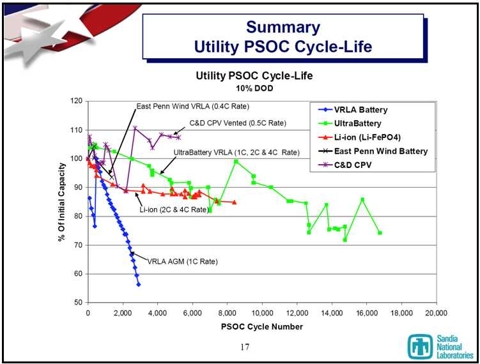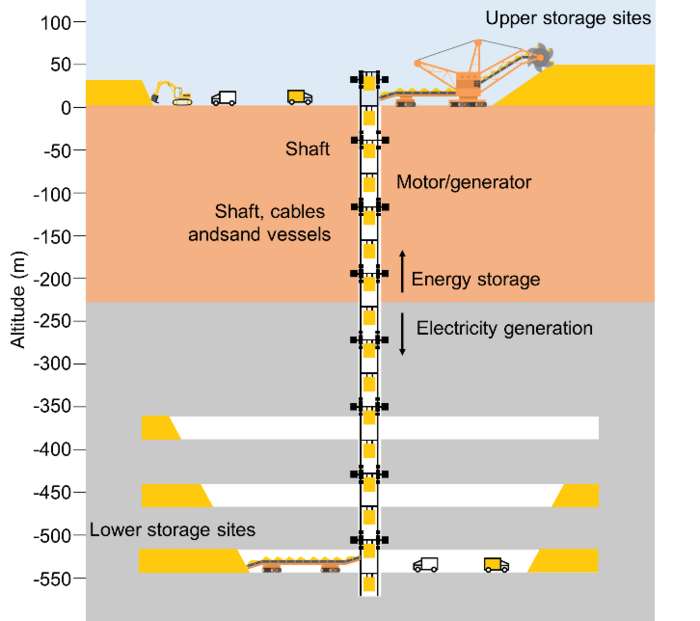
For several months I’ve been telling readers that emerging lead-carbon battery technologies will be game changers in alternative energy storage.
Last week, The Economist published an article about Axion Power International (AXPW.OB) titled “Lead-acid Batteries Recharged” and I found a recent report from Sandia National Laboratories on its side-by-side testing of lead-acid, lead-carbon and Li-ion batteries. Now that Axion’s management is talking to the press and Sandia is releasing independent data, I feel free to explain more fully why lead-carbon technology is so disruptive. I don’t like table pounding, but this is probably the most important Seeking Alpha article I’ve written.
Lead-carbon batteries are different from other types of batteries because they combine the high energy density of a battery and the high specific power of a supercapacitor in a single low-cost device. The primary goals of lead-carbon research have been to extend the cycle lives of lead-acid batteries and increase their power. Basically, developers start with conventional lead-acid chemistry and add carbon components to the negative electrodes. While the carbon components do not change the basic electrochemistry, they increase specific power and reduce a chemical reaction called “sulfation” that occurs during charging cycles and is the principal reason ordinary lead-acid batteries fail. Over the last several years, lead-carbon researchers have followed three different development paths:
- Blending carbon additives into the lead sulfate paste that is used for negative electrodes;
- Developing split-electrodes where half of the negative electrode is lead and the other half is carbon; and
- Completely replacing the lead-based negative electrode with a carbon electrode assembly.
The DOE’s 2008 Peer Review for its Energy Storage Systems Research Program included a slide presentation from Sandia that summarized the results of its cycle-life tests on five different batteries including a deep-cycle lead-acid battery, two lead-acid batteries with carbon enhanced pastes, a split-electrode lead-carbon battery (the Ultrabattery) and an advanced lithium-ion (Li-FePO4) battery. While the tests performed by Sandia focused on smoothing power output from wind turbines and used a 10% depth of discharge from a 50% initial state of charge, which means more testing will be required before comprehensive comparisons are possible, the following graph highlights the magnitude of the cycle-life improvements that lead-carbon technologies offer today.
The Latest Bing News on:
Alternative energy storage
- As energy storage surges, second Portland flow battery startup emergeson May 9, 2024 at 11:47 am
All the parts are coming together. Can they come together fast enough for the kind of timescale that a startup needs to survive? On the other hand, here we are, six years after we first started and we ...
- FM Global introduces renewable energy uniton May 9, 2024 at 3:37 am
Starting in July, FM Global will offer a new policy specifically tailored for renewable energy operations in the US. Following this, next year will see the introduction of a renewable energy ...
- Eos Energy Enterprises Announces Participation in Upcoming Investor Conferenceson May 9, 2024 at 12:29 am
Safe, scalable, efficient, sustainable—and manufactured in the U.S—it's the core of our innovative systems that today provide utility, industrial, and commercial customers with a proven, reliable ...
- Co-location of solar PV and energy storage: A key trend shaping the future of solar energy in SEEon May 8, 2024 at 5:00 pm
The competitive generation costs of solar PV make it an attractive alternative to traditional energy sources ... In the face of slow grid development, energy storage and flexible demand are stepping ...
- Innovative activated carbon from palm kernel shells enhances methane storageon May 6, 2024 at 4:59 pm
In a significant development for clean energy, researchers at ... being recognized for its potential as an alternative to traditional fossil fuels. The team aimed to improve the adsorptive properties ...
- Clean-energy producer Allete agrees to go private for $6.2 billionon May 6, 2024 at 6:43 am
Power producer Allete Inc. said Monday it agreed to go private for $67 a share in a deal valued at about $6.2 billion including debt with buyers Canada Pension Plan Investment Board and Global ...
- Renewable energy is abundant, but we need a system to get it across state lines | Letteron May 4, 2024 at 7:43 am
The recent Shannon Osaka article about the abundance of California’s solar production highlights a real need to deal with a good thing. Opponents of solar and other alternative energy sources always ...
- A massive battery storage plant is in the works in Morro Bay. Here’s a look at the project siteon April 30, 2024 at 12:31 pm
The city Planning Commission is expected to review the environmental impact report for the project next month.
- Reimagining energy: How former fossil fuel sites are driving the renewable revolutionon April 30, 2024 at 6:28 am
We examined the transformations of steel mills into wind turbine hubs, coal mines into solar sanctuaries, and more.
- Disrupting Energy Storageon April 25, 2024 at 10:05 am
There’s a great deal of research taking place with battery technologies to find a viable alternative to lithium-ion (Li-ion) batteries, which will find its way to the power ...
The Latest Google Headlines on:
Alternative energy storage
[google_news title=”” keyword=”alternative energy storage” num_posts=”10″ blurb_length=”0″ show_thumb=”left”]
The Latest Bing News on:
Energy storage systems
- A Staggering 19x Energy Jump in Capacitors May Be the Beginning of the End for Batterieson May 9, 2024 at 8:57 am
While batteries excel in storage capacity, they fall short in speed, unable to charge or discharge rapidly. Capacitors fill this gap, delivering the quick energy bursts that power-intensive devices ...
- National Labs Guide Critical AI, Energy Storage, And Grid Researchon May 9, 2024 at 6:00 am
Artificial intelligence and other technologies will take energy production and deliverty to a new level, helping increase reliability, reduce emissions, and cut costs.
- Energy Vault to deploy two battery energy storage systems in Australiaon May 9, 2024 at 5:52 am
Energy Vault (NYSE:NRGV) +2.8% pre-market Thursday after saying it reached agreements to deploy two battery energy storage systems totaling 400 MWh in Australia; financial terms were not disclosed.
- Companies ink major deal on energy storage system: 'To ensure a stable and reliable energy grid'on May 9, 2024 at 3:30 am
Because the battery system will store this energy from wind and solar power, it will also be clean, making it safer and more sustainable. Companies ink major deal on energy storage system: 'To ensure ...
- Energy Vault, ACEN Australia Announce Agreement for 400 MWh of Battery Energy Storage Deploymentson May 9, 2024 at 1:00 am
“Energy Vault’s ability to work with our Siemens S120 converters will be particularly valuable as we optimize our battery storage systems for maximum efficiency and impact.” The BESS deployments, ...
- Co-location of solar PV and energy storage: A key trend shaping the future of solar energy in SEEon May 8, 2024 at 5:00 pm
Battery energy storage systems (BESS), on the other hand, offer a more intricate solution, balancing power absorption and injection while maximising revenue across different market segments. The ...
- Energy Vault successfully tests, commissions gravity storage system in Chinaon May 8, 2024 at 10:17 am
Testing included the successful charging and discharging of units of the 25 MW/100 MWh gravity energy storage system.
- Vermont utility approved for 5-MW energy storage projecton May 8, 2024 at 9:55 am
Not-for-profit public utility Morrisville Water and Light (MWL) is bolstering its grid reliability after the unanimous approval from its board of trustees ...
- IPCL, E2S to develop Thermal Energy Storage System for efficient storage, transmissionon May 8, 2024 at 4:54 am
The 250Kwh TESS, developed by E2S, has been synchronized with the IPCL system and will help the company achieve its goal of integrating 80 per cent renewable energy into the distribution system by the ...
- Thermal Energy Storage Innovation: IPCL and E2S Collaborate on Efficient Storage and Transmissionon May 8, 2024 at 4:10 am
India Power and E2S collaborate to establish Thermal Energy Storage System (TESS) for energy efficiency. The 250Kwh TESS, integrated with IPCL, supports the company's goal of integrating 80% renewable ...
The Latest Google Headlines on:
Energy storage systems
[google_news title=”” keyword=”energy storage systems” num_posts=”10″ blurb_length=”0″ show_thumb=”left”]









